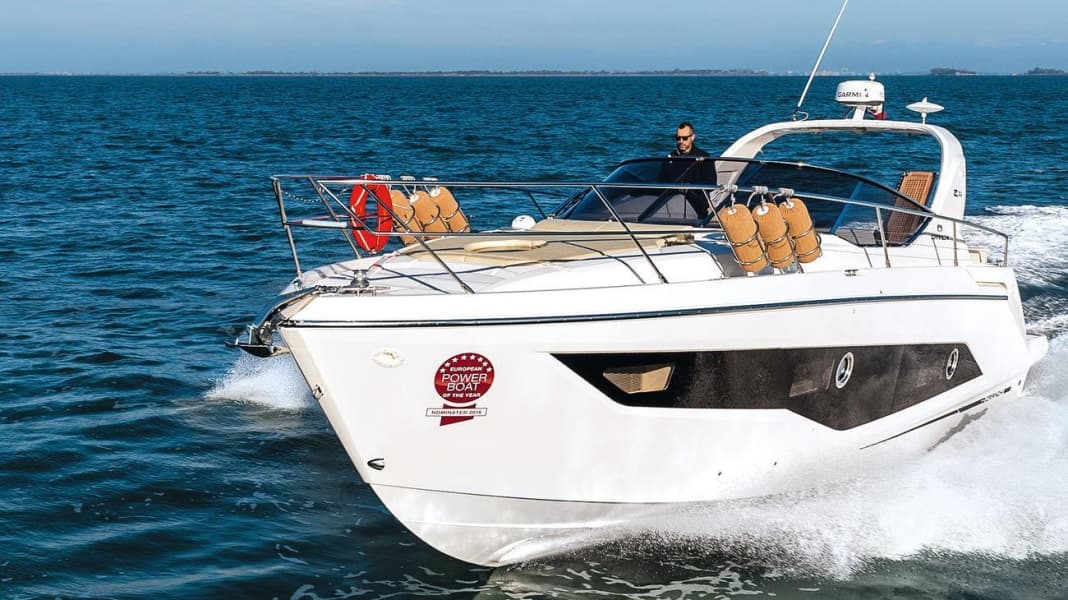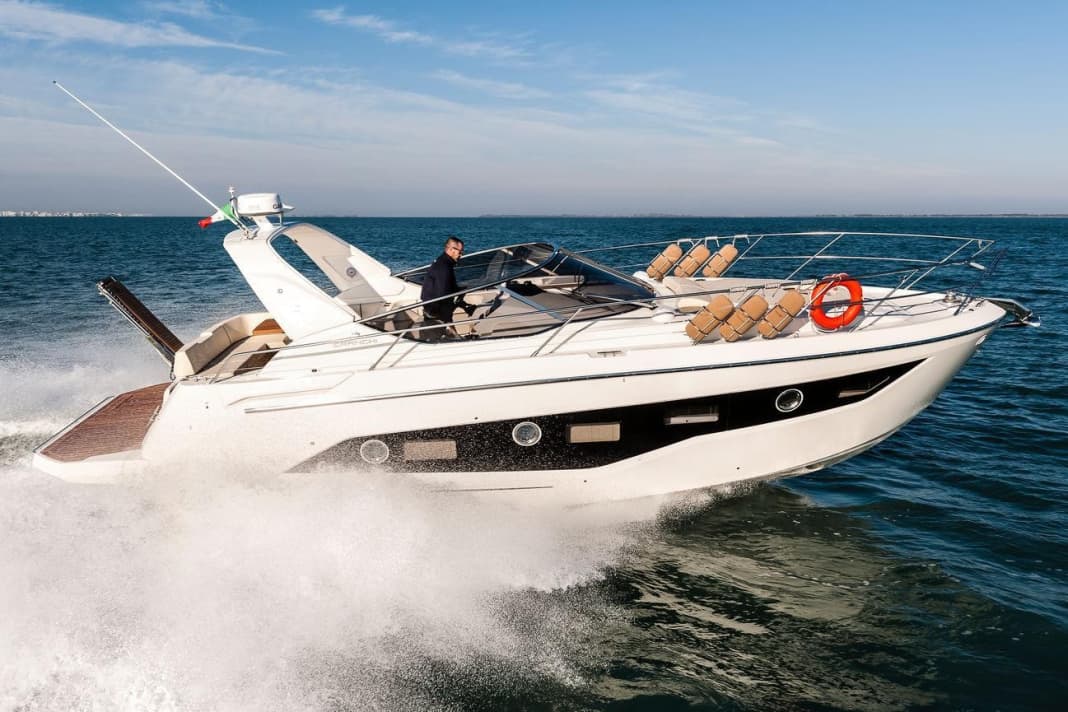
TheItalian shipyard Cranchi is broadly positioned. It offerscurrently 18 models - from day cruisers just under 8 metres long for outboard motors to inboard cabin boats, trawlers and yachts that end at 19 metres.
The boatyard has been in existence since 1870 and is one of the most modern in Europe. With its focus on the latest technology and the highest quality, it has been successful; it has already won several Cranchi boats asEuropean Powerboat of the Yearhonoured. The Z 35 was also among the nominees for this year's title.
In terms of exterior and interior finish as well as technical and electrical installation, it leaves an overall impression.very clean impression. The interior fittings are homogeneous, and the boat scores high marks for woodworking, paintwork and upholstery inside and out. Incidentally, despite the name, the Z 35 is not a 35-foot boat, but just over 38 feet long, so it measures a whole metre longer.






Driving and manoeuvring
Two engines plus bow thruster guarantee manoeuvrability during slow manoeuvres such as mooring or casting off. During slow manoeuvres (7 knots), we run both engines at a maximum of 1000 rpm so that the waves generated by the boat do not interfere.
With the drives fully trimmed and the trim tabs in the zero position, the Z 35 can switch quickly from displacement to planing speed with good foresight and without trimming too much.
We measured the lowest possible planing speed at 18 kn (2300 rpm), the maximum speed at just under 35.5 kn and 100 rpm above the rated speed. In view of the load, this speaks in favour of suitable propellers.
After analysing our measured values, we found that the Z 35 is economical in a range between 2500 and 3000 rpm or from 22 to 28 kn in fast planing speed. One tank of fuel is then theoretically sufficient for 227 to 214 nm and at full throttle for around 166 nm plus 15% reserve. Target met - good.
AllThe Z 35 completes extreme manoeuvres at top speed with flying coloursBoth in the imaginary slalom course, where the boat is made to swing along its longitudinal axis without endangering the occupants, and when the rudder is torn, where it follows the course once set without complaint.
The same applies to the 180° turns, which are completed in a radius of around one and a half boat lengths in one go without the hull catching. Only if the drives remain in the trimmed position is this noticeable with a settling movement, which is not too strong, however.
Outstanding: If necessary, the test boat can also be driven with just one engine; it is then just over 11 knots fast and can theoretically travel just under 150 nm on a full tank (plus reserve).
OurTest area is the Laguna di Marano on the northern Adriatic between Venice and Trieste, where the Cranchi test centre is located. A steel-blue sky and an only slightly choppy sea are not suitable for a rough water test, so the boat's own waves and those generated by fishing boats have to do the job. The test boat copes with these without too much fuss and shows that it is also capable of handling larger calibres.
The skipper sits on anon-adjustable bench with a partially folding seat and has a good view of all instruments and what is happening on the water; however, when the fender baskets are fitted, they restrict the field of vision. We also find theReflections in the windscreenThe tint of the windscreen wiper should be a little lighter for our liking. It is also made of plastic and appears less suitable for use with windscreen wipers due to its low scratch resistance.
The hydraulic steering works smoothly as long as the rudder is not moved too quickly. In this case, hectic movements are dampened by a build-up of resistance, which also serves to improve safety.
Technology and safety
A floor hatch in the cockpit provides access to the engine compartment. We have to criticise the fact that this does not seal against the engine compartment cut-out and cockpit drainage and therefore also allows engine noise to escape. Two steps serve as an entry aid.
With two engines, accessories and units, the engine compartment is well filled, especially as the ceiling (cockpit floor) is not too high above the engines. You only go down there if you have to, and a slim mechanic has an advantage when carrying out service or repair work. The engine compartment ceiling can be removed for inspection.
The main switches are easily accessible in the cockpit pantry and the thermal fuses in the switch panel in the saloon. The sparing use of handrails and grab handles in the cockpit and the storage compartment for the gas bottle under the driver's seat, whose ventilation does not comply with German standards, are criticised. And if fuel pre-filters are to be installed (which is actually commendable), then please also include water alarm sensors. Without them, this device makes little sense. Also inappropriate: the swan neck of the petrol tank vent ends far below the filler neck.
Otherwise, all the standards we require are met, such as a fire extinguishing system, remote shut-off and mechanical fuel taps or manual and electric bilge pumps. A fire test of a sample of the engine compartment insulation taken from all sides showed it to be flammable but self-extinguishing. Thanks to its good and, above all, safe handling characteristics, the Z 35 scored highly in this category overall.
Living, cockpit and equipment
The lower deck is filled with the bow cabin, the owner's cabin aft and between them the saloon with the fully equipped galley and the dinette that can be converted into an emergency berth. Not to forget: a bathroom with sea toilet. Apart from the doors of the cabins and the bathroom, which were a little too narrow for the tester, the dimensions are correct in all areas.
Sleeping is on well-sized double berths, and thanks to the space and window fronts, the living comfort below deck is more than pleasant. The fact that there is no lack of storage space here or on deck is part of the concept.
The cockpit is dominated by the aft seating area, which can be converted into a large sunbed, and a forward seating area plus driving position. The sun lounger at the front can be accessed either via steps and the folding windscreen centre section or via the side decks. The railing and windscreen frame provide good support. The Z 35 can be accessed from aft either via the centrally mounted gangway or via the projecting bathing platform and stern door on the starboard side.
A word about the equipment: the shipyard delivers the Z 35 ready to sail. Thanks to a well-stocked list of accessories, you have the option of customising the boat and tailoring it to your personal taste. The fact that you also have to buy essentials such as a holding tank, depth sounder, canopy or tarpaulin is part of the marketing process, just like anywhere else.
Conclusion
All in all, the Z 35 is a neatly finished boat with appealing and, above all, safe handling that can be given to anyone. The space on and below deck is pleasing, although it would need a few more handholds. The shipyard publishes realistic consumption data, and the figures almost match our test.
Data sheet: Cranchi Z 35
Shipyard: Cantiere Nautico Cranchi S.p.A.
Type designation: Cranchi Z 35
CE category: B - Outside coastal waters
Material of hull and deck: Plastic
Length: 11,70 m
Width: 3,53 m
Displacement: 7,25 t
Price: 273.688,00 €

